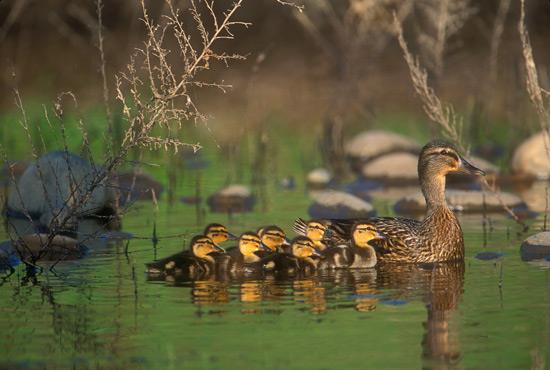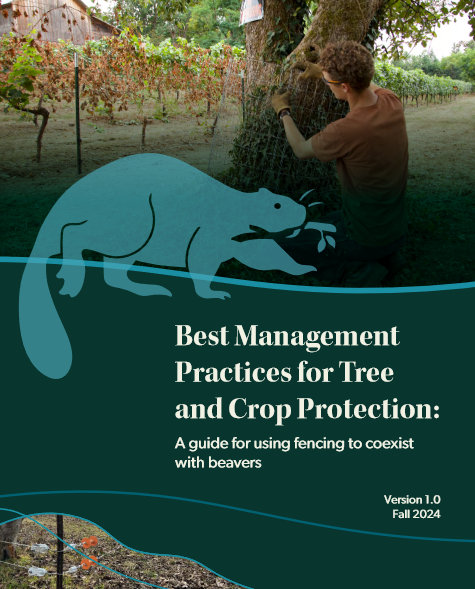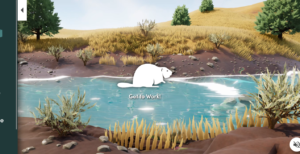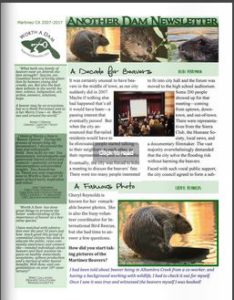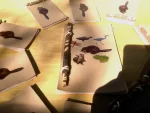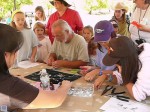 This was what I had been anxiously waiting for. Turns out I was nervous for no reason at all. Thank you Sam Richards for writing something so kindly and thoughtful. I promise no money or beaver merchandise exchanged hands. A beaver festival article will follow on Thursday. I’m posting the whole thing here and on my mother’s refrigerator, but please CLICK on the link so they know you read it okay?
This was what I had been anxiously waiting for. Turns out I was nervous for no reason at all. Thank you Sam Richards for writing something so kindly and thoughtful. I promise no money or beaver merchandise exchanged hands. A beaver festival article will follow on Thursday. I’m posting the whole thing here and on my mother’s refrigerator, but please CLICK on the link so they know you read it okay?
‘Weekend project’ to help local beavers turns into labor of love for Martinez woman
By Sam Richards
MARTINEZ — Heidi Perryman had no idea her “weekend project” was going to last the better part of a decade — or have such wide impact.
But creating public awareness of the importance of beavers to the ecological health of the streams in which they live and championing the toothy rodents that have made Alhambra Creek an unlikely destination for environmentalists has become almost a second career for this 49-year-old child psychologist and lifelong Martinez resident.
She takes pride in the degree to which she and those whom she has influenced have spread the message that beavers are good for the ecosystem. She also knows the work is far from done.
“It’s constantly surprising to me how successful we’ve been but also how much subtle backlash there continues to be,” said Perryman, who remains a driving force behind the local Beaver Festival, its eighth annual edition happening Saturday.
The festival has grown from a small gathering of 200 in 2008 (“We figured it would be bad to kill the beavers if we had just had a party for them!” Perryman said) to an event that drew more than 2,000 visitors last year to the small open parcel — called “Beaver Park” by some — adjacent to the creek, a stone’s throw from the Amtrak station.
My goodness, what a fantastic start to an article! Sam asked so many questions about me, the beavers and the community they inspired I didn’t know what to expect. I certainly didn’t expect this. Honestly, this article is much nicer than I deserve. I was really just hoping it wouldn’t make people LESS likely to come to the festival. (Although, I’ve heard a rumor that a certain Martinez cabal meets for breakfast every morning downtown to discuss city plans for the day. I would dearly love to be the fly on the wall when they see this in their morning paper.)
Perryman said she was walking downtown in 2007 when she ran into a friend who told her beavers had recently migrated to Alhambra Creek. “I thought it was funny, and I came down to see them,” she said.
Not so funny was learning the beavers were going to be killed, as downtown property owners feared flood damage caused or exacerbated by the rodents’ dams.
She then joined the Martinez City Council’s “beaver subcommittee,” diving into what had become an emotional, divisive debate.
“Heidi was less excitable than some of the people on the other side of that issue, which was a good thing,” said City Councilman Mark Ross, who favored researching the matter.
Perryman has been credited with leading the drive to research the impacts of urban beavers, both good and bad, on their surroundings.
Harriett Burt, a former Martinez councilwoman, initially wanted the beavers gone, fearing flood damage to nearby buildings. But she said the research done by Perryman and her fellow Worth a Dam beaver advocates turned up viable options for preserving the beavers when official sentiment was going the other direction.
“She was clear, competent, articulate, well-informed and thorough,” Burt said. “She did have to win me over, and she did.”
The Worth a Dam group, she added, forced the City Council to look at other solutions.
There are three things I’m proudest about in my work on the committee, keeping my temper (most of the time), convincing Igor Skaredoff and Mitch Avalon that beavers are good for creeks, and persuading Harriet Burt that Beavers could belong in Martinez. I’m so happy he talked to her and she was kind enough to give such a quote. Harriet was my vice principal in middle school and the mayor of Martinez when I got my last degree. She was the planning commission forever and welcomed us when we bought this old house downtown. This really means a lot coming from her.
While Perryman had to stand up to beaver opponents, she also had to get to know their advocates.
“She knows how to engage other people who are themselves involved with that issue and make them all part of the same coalition,” said Igor Skaredoff, who since 1990 has been a member of Friends of Alhambra Creek.
In an effort to coexist with the paddletail swimmers, the city employed a version of a flow device, called by its inventor Skip Lisle the “beaver deceiver.” It’s a plastic pipe that carries water under the beavers’ then-main dam between Escobar Street and Marina Vista. It ensures the water level behind the dam never rises too high and that the beavers can’t tell water is getting through, which could send them into a damming frenzy.
Perryman said that now, seven years after the “beaver deceiver” was installed, the beavers appear to have finally realized the deception. That’s probably the biggest reason their main dam is now several hundred feet farther downstream, adjacent to that small park near the train station.
“Seven years, I would say the ‘beaver deceiver’ was a success,” said Perryman.
There are no plans to move the pipe to the new dam, as any flooding there would only inundate an adjacent floodplain and not endanger buildings.
Oooh nice PS for the council, “don’t worry about the new dam, Everything will be fine”. Could there be a better fortune hidden inside this cookie?
Walking slowly one recent morning onto the footbridge, using a cane, Perryman looked out over a creek more alive than eight years ago, an ecosystem largely restored. More fish, plus muskrats, river otters and other species, come (and go) now almost certainly because of the beavers’ activity, Perryman said. They stir up the creek bed, exposing insects and other creatures, which attract the fish that eat them.
The fish, in turn, attract otters and mink, which also have been sighted. Even the largely vegetarian muskrats eat some of these critters. The beaver dams also help keep more water in the creek longer, lessening local effects of the drought on surrounding trees and plants.
But there’s more to do; on the Worth a Dam agenda is work to change California fish and game laws to allow relocation of beavers to where they would be a good ecological fit.
Perryman also wants to continue to be a resource to the other beaver advocacy groups; their numbers are growing, and such units from San Jose, Napa and Lake Tahoe are expected Saturday at the Martinez festival.
The festival and the beavers themselves have helped give Martinez a little publicity. There are bumper stickers and T-shirts touting “Mtz. Beavers,” and those who gather on that footbridge are a mix of locals and out-of-towners.
“It’s rare to find a beaver dam so close to a parking meter,” Ross said.
HEIDI PERRYMAN Age: 49 Hometown: Martinez Claim to fame: Child psychologist who fought starting in 2008 to keep beavers in Alhambra Creek; lead organizer of Martinez’s annual Beaver Festival Quote: “I thought I’d work a day, or a weekend, on helping the beavers. But it really sort of took off.” MARTINEZ BEAVER FESTIVAL VIII When: 11 a.m. to 4 p.m. Saturday Where: Marina Vista and Alhambra Avenue, downtown Martinez Cost: Free Information: www.martinezbeavers.org/wordpress What a wonderful article, Sam Richards. I am totally grateful AND relieved. The child in me is pretty proud, so I’m including this photo of young Heidi showing off my crafting talents with a “little house on the prairie inspired” corncob doll while camping.
What a wonderful article, Sam Richards. I am totally grateful AND relieved. The child in me is pretty proud, so I’m including this photo of young Heidi showing off my crafting talents with a “little house on the prairie inspired” corncob doll while camping.
One thing that didn’t make it in was the fact that I gave a TON of credit to the people of Martinez who marched to that meeting and demanded to live with beavers. And to the beavers themselves, who oddly decided to live in a very public area where people could see and care about them. Maybe he thought I was just being humble, but they really deserve the credit. Honestly, save this article for my eulogy. I am way prouder of the beavers than my dissertation. (The article says so exactly what I secretly wished it would that I am weirdly worried that something terrible will happen now.)
What the heck. This poem-alteration seems totally fitting this morning. (Apologies to Leigh Hunt.)
I saved beavers in our creek Kept them safe from traps and trials Whatever else I couldn’t do They were spared the city’s wiles Say I’m weary, say I’m sad Atheist among believers Say I’m getting old but add Add that I saved beavers


 (Jon got so excited about him that he told Suzi to get a photo, and when she was trying to walk around the edge of the pond she slipped in! About three feet deep because of the swelling tide, but she instinctively held her camera over her head so everything important except her squishy boots was saved! Afterwards Jon was very sorry apologetic.)
(Jon got so excited about him that he told Suzi to get a photo, and when she was trying to walk around the edge of the pond she slipped in! About three feet deep because of the swelling tide, but she instinctively held her camera over her head so everything important except her squishy boots was saved! Afterwards Jon was very sorry apologetic.)



 Understanding Waterfowl: Beaver Ponds and Breeding Ducks – Growing beaver populations have created an abundance of high-quality habitat for waterfowl
Understanding Waterfowl: Beaver Ponds and Breeding Ducks – Growing beaver populations have created an abundance of high-quality habitat for waterfowl